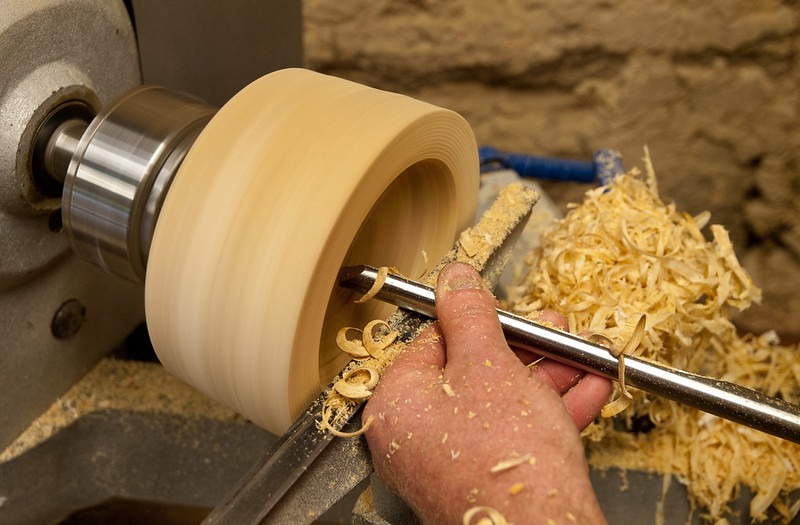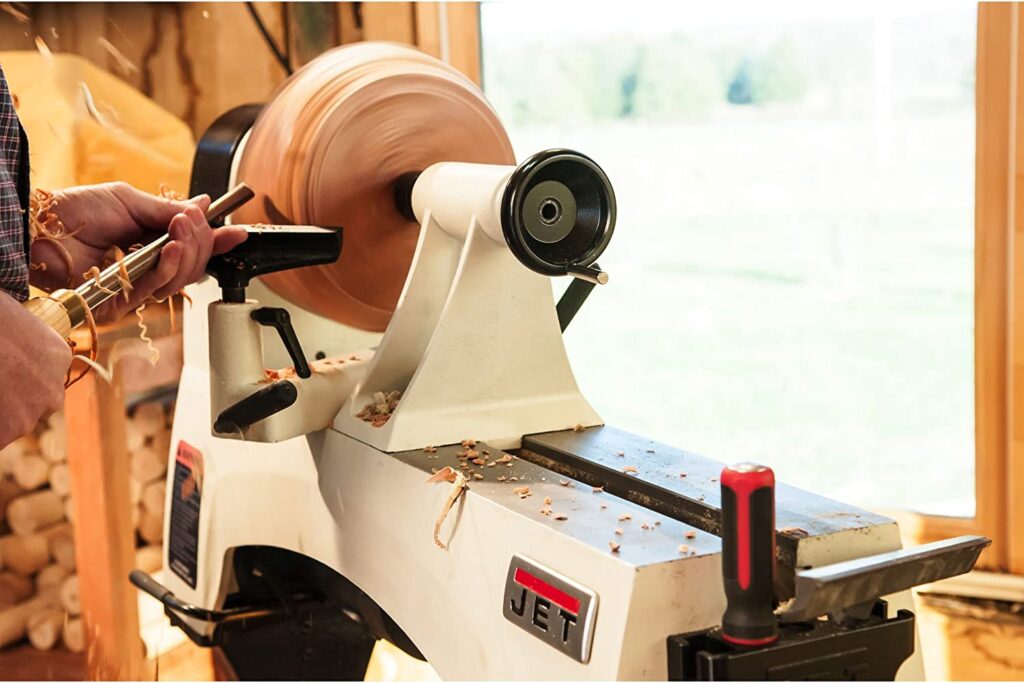Woodturning is a vital part of woodworker’s lives as a way to advance their abilities to produce a wider variety of crafts with the lathe.
The lathe may seem like a large investment at first, however with the proper knowledge you can find a number of ways to monetize your beautiful creation.
Let’s explore the woodturning lathe a bit more in detail…
Here’s What You Should Know About a Woodturning Lathe
A woodturning lathe is a specialized tool used to carve and cut a wood piece with precision and speed. The lathe holds the wood piece in place while spinning it at rapid speeds. Fixed or hand-held cutting tools are then used to shape the wood piece uniformly around its center-line of rotation.
Table of Contents

What is a Woodturning Lathe Used For?
A woodturning lathe is a tool used to hold a wooden piece in place while cutting the wood into the desired shape. This process enables the lathe to do a variety of tasks other than simply cutting the wood.
A lathe can be utilized to sand and carve, so that the craftsman can accomplish a multitude of tasks with one tool.
With the lathe, a woodworker can carve things such as legs for furniture, headboards for beds, banister posts for staircases, and smaller items such as bowls as well.
Some interesting facts about the woodturning lathe:
It is a very useful tool for making a variety of creations such as bangles, beads, heads to banister posts, and other ornamental designs.
It is similar to the metal lathe in that it cuts, carves, and enables the craftsman to dig into the product to create a whole new shape. This is useful for making bowls and other kitchen utensils.
It isn’t especially large in comparison to other tools which might be used for woodworking, and even though it may require an initial investment of some five or six hundred dollars; it can easily be utilized to create products to be sold and gifted to others.
How Does a Wood Turning Lathe Work?
The primary function of the woodturning lathe is to turn and spin the wood in such a way that the craftsman can carve, and gauge into the wood more effectively than if he did not have the lathe.
The spindle on the end of the lathe spins at the appropriate speed conducive to the project the workman is creating. The wooden piece is then attached to the spindle and the craftsman can sand the wood, carve the wood, and otherwise break down the wood into the desired shape.
The spinning is usually powered by an internal motor, and it can be altered to produce more or less power and speed. Although, back when this tool was first invented, it was powered manually by a foot-powered pedal that propelled the spindle.
The lathe enables the craftsman to make objects such as wooden beads, bowls, and other objects which otherwise would be very difficult or virtually impossible.
Here is a really cool video on how a woodturning lathe works.
What Accessories Would You Need for a Wood Turning Lathe?
There are many accessories one may get for their lathe; however these are some of the most essential to your work.
- Roughing gouge
There is the roughing gouge, used for shaping and carving out wood to your desired tastes. Think of this tool as a way to carve deeply into your wood in order to create a deep cut into the wood.
It is not recommended that this tool be used for larger carving tasks, such as for a basin or bowl; however, it is a great tool for carving intricate designs and patterns into your wood piece.
- Faceplate
The faceplate is an essential part of the wooden lathe. It sits at the end of the spindle and spins at a relatively fast speed to enable the worker to smooth, carve, and otherwise shape the wood into the desired shape.
The faceplate holds wood to the end of the spindle and comes in a variety of sizes in order to accommodate a large variety of creations ranging from banisters to bowls.
It is recommended that for larger projects, such as a large wooden fruit bowl, you use a 6-inch faceplate versus a smaller faceplate for something like a head to a corner post for a banister.
- Skew Chisel
The skew chisel is an important part of the carving tools for the lathe. It is positioned at an angle against the wooden piece, and the bevel turns while the skew chisel is aligned against the edge and carves into it.
This tool is used to create V cuts into the wood in order to create beads and other ornate designs.
Can You Turn Wood Without a Lathe?
The short answer would be that yes, you technically can turn without a lathe. Or at least, people have claimed to have done it. It is done by converting your lathes drill and creating a makeshift faceplate.
Although, the general consensus is that this is only really effective with larger projects such as furniture legs. Additionally, it seems to add a level of complexity and frustration that most don’t wish to deal with.
Are Wood Turning Lathes Expensive?
The average wood lathe costs around $600.00 for a well built and mid range priced machine. Although, there are high end machines which can go for over $2,000.00.
How do you determine which is worth the price?
It depends upon what it is you are looking to make, and how experienced you are…
Most beginners will be satisfied with a cheaper model, primarily to serve as an experimental tool for the woodworker to become better acclimated to the way the machine turns, the speeds available, and how much pressure to use while using such tools as the skew chisel.
What is a Good Wood Turning Lathe for Beginners?
One of the main things a woodturner wants when they first start is a stable machine.
If the machine wobbles a lot, or if the speed is difficult to manage, it can make the learning experience unpleasant.
The machine which seems to be best suited to meet this need is the JET JWL1221VS 12 inch Variable Wood Lathe from Amazon.

This machine is known for its steady speed, its stable grip, and ability to adjust from reverse to forward with ease.
What are Some Good Woodturning Projects for Beginners?
Some of the best beginner woodturning projects are the ones that help you get accustomed to the movements of the machine. It’s best to start with a project which challenges the user just enough so they become comfortable with the movements of the machine.
- Rings
Making rings with the lathe is a wonderful way to practice using the lathe, especially with how to handle making curves in the wood.
- Flower Pots
Flower pots are a good practice project because they primarily involve smoothing out the wood and this is a great way for a beginner to learn how to handle the machine.
Flower pots are usually simple and are more for display purposes than utility, but they are quite lovely.
- Candle Holders
Lastly, candle holders or tea light candle holders are a great project for beginners and for anyone who might want to make a little money with their woodworking.
They are beginner-friendly in that they do not require a great deal of intricate carving, and they can be made with simple pieces of wood.
What is the Difference Between a Metal Lathe and a Wood Lathe?
This may seem obvious to state, but the main difference between the two lathes is one is specifically designed for only wood while the other is for metal.
A metal lathe is very fast and has a lot of might behind it, which makes sense when you consider it is used for cutting different types of metals.
In comparison, the wooden lathe is much smaller and less powerful than the metal lathe. It can only be used for wood, and therefore it is much slower and has much less force behind it.
Can a Metal Lathe be Used for Woodturning?
Yes, in fact, it can! A metal lathe can be used to turn both metals and wood for your woodworking purposes.
There are just 2 things to take into consideration:
- The price
A metal lathe is much more expensive than a wooden lathe. Whereas an average wooden lathe goes for about $600.00, a large and sturdy metal lathe tends to be in the range of $1,500.00.
- The size and strength
The metal lathe is very strong, very powerful, and therefore it can make turning more difficult when it comes to turning wood. This means if you are going to get a metal lathe, you should probably be sure you are seasoned with turning.
Lastly, the size is a factor if you do not have adequate space to store it. Just keep in mind when making your purchase just how much space you have to store and keep this bulky object.
